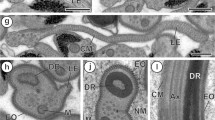Abstract
The movement of radiolabelled non-self sperm within the female reproductive tract of cultured specimens of the hermaphroditic ascidian Diplosoma listerianum Milne Edwards was investigated by light-microscope autoradiography. Passage of male gametes up the oviduct (fertilization canal) to the ovary was demonstrated for sperm known unequivocally to be of external (non-self) origin. The lumen of the ovary was directly confirmed as a site of long-term storage of sperm, as had previously been suggested from circumstantial evidence. The ovary had a branching structure. Sperm entered blind diverticula leading from the main lumen of the ovary, and persisted there adjacent to the oocyte at the end of each of these side-branches. This arrangement included the association of stored sperm with very small, immature oocytes. An investigation of the time-course of sperm uptake showed that exogenous sperm did not enter the oviducts of recipient ramets for some time (>3 h) after they were initially available, with first presence of sperm noted in the distal half of the duct at 9 h and greatest recorded uptake at 27 h. Sperm had reached the ovary 6.6 h after the first observation of their occurrence in the distal part of the oviduct. Uptake declined steeply between 27 and 46.8 h of continual exposure to sperm released by a single genetic source, and remained low at 81 h. The significance of these observations for the mating pattern of D. listerianum is discussed.
Similar content being viewed by others
References
Beeman RD (1970) An autoradiographic study of sperm exchange and storage in a sea hare, Phyllaplysia taylori, a hermaphroditic gastropod (Opisthobranchia: Anaspidea). J exp Zool 175: 125–132
Berrill NJ (1975) Chordata: Tunicata. In: Giese AC, Pearse JS (eds) Reproduction of marine invertebrates. Vol. 2. Entoprocts and lesser coelomates. Academic Press, New York, pp 241–282
Birkhead T, Møller A (1993) Female control of paternity. Trends Ecol Evolut 8: 100–104
Birkhead TR, Møller AP, Sutherland WJ (1993) Why do females make it so difficult for males to fertilize their eggs? J theor Biol 161: 51–60
Bishop JDD, Ryland JS (1991) Storage of exogenous sperm by the compound ascidian Diplosoma listerianum. Mar Biol 108: 111–118
Bishop JDD, Ryland JS (1993) Enzyme electrophoretic evidence for the prevalence of outcrossing in the hermaphroditic brooding ascidian Dendrodoa grossularia (Chordata, Urochordata). J exp mar Biol Ecol 168: 149–165
Burighel P, Martinucci GB (1994a) Sexual reproduction in the compound ascidian Diplosoma listerianum (Tunicata). I. Metamorphosis, storage and phagocytosis of sperm in female duct. Mar Biol 118: 489–498
Burighel P, Martinucci GB (1994b) Sexual reproduction in the compound ascidian Diplosoma listerianum (Tunicata). II. Sperm penetration through ovary wall and evidence of internal fertilization. Mar Biol 118: 499–510
Burighel P, Martinucci GB, Magri F (1985) Unusual structures in the spermatozoa of the ascidians Lissoclinum perforatum and Diplosoma listerianum (Didemnidae). Cell Tissue Res 241: 513–521
Burighel P, Martinucci GB, Zaniolo G (1986) Ovulation in the ovoviviparous ascidian, Diplosoma listerianum. Acta Embryol Morph exp (NS) 7: 102–103
Carlisle DB (1953) Presenza di spicole in Diplosoma listerianum (Milne Edwards). Contributo alla sistematica degli Ascidiacea, Didemnidae. Pubbl Staz zool Napoli 24: 61–67
Cloney RA (1990) Urochordata — Ascidiacea. In: Adiyodi KG, Adiyodi RG (eds) Reproductive biology of invertebrates. Vol. IV. Part B. Fertilization, development, and parental care. Oxford & IBH Publishing, New Delhi, pp 391–451
Cohen S (1990) Outcrossing in field populations of two species of self-fertile ascidians. J exp mar Biol Ecol 140: 147–158
Flitney FW (1977) Autoradiography. In: Bancroft JD, Stevens A (eds) Theory and practice of histological techniques. Churchill Livingstone, Edinburgh/London/New York, pp 371–386
Holland LZ, Miller RL (1994) Mechanism of internal fertilization in Pegea socia (Tunicata, Thaliacea), a salp with a solid oviduct. J Morph 219: 257–267
Mackie GO, Singla CL (1987) Impulse propagation and contraction in the tunic of a compound ascidian. Biol Bull mar biol Lab, Woods Hole 173: 188–204
Martinucci GB, Burighel P, Zaniolo G, Brunetti R (1988) Ovulation and egg segregation in the tunic of a colonial ascidian, Diplosoma listerianum (Tunicata, Ascidiacea). Zoomorphology 108: 219–227
Milkman R (1967) Genetic and developmental studies on Botryllus schlosseri. Biol Bull mar biol Lab, Woods Hole 132: 229–243
Miller RL (1994) Mechanisms for enhancing fertilization success in two species of free-spawning invertebrates with internal fertilization. In: Wilson WH Jr, Stricker SA, Shinn GL (eds) Reproduction and development of marine invertebrates. Johns Hopkins University Press, Baltimore/London, pp 106–117
Mukai H, Watanabe H (1977) Shedding of gametes in the compound ascidian Botryllus primigenus. Mar Biol 39: 311–317
Nollen PM (1968) Autoradiographic studies on reproduction in Philophthalmus megalurus (Cort, 1914) (Trematoda). J Parasit 544: 43–48
Picard A (1980) Spermatogenesis and sperm-spermatheca relations in Spirorbis spirorbis (L.). Int J Invert Reprod 2: 73–83
Ryland JS, Bishop JDD (1990) Prevalence of cross-fertilization in the hermaphroditic compound ascidian Diplosoma listerianum. Mar Ecol Prog Ser 61: 125–132
Sabbadin A (1971) Self and cross-fertilization in the compound ascidian Botryllus schlosseri. Devl Biol 24: 379–391
Scofield VL, Schlumpberger JM, West LA, Weissman IL (1982) Protochordate allorecognition is controlled by a MHC-like gene system. Nature, Lond 295: 499–502
Snow AA, Spira TP (1991) Differential pollen-tube growth rates and nonrandom fertilization in Hibiscus moscheutos (Malvaceae). Am J Bot 78: 1419–1426
Svane I, Young CM (1989) The ecology and behaviour of ascidian larvae. Oceanogr mar Biol A Rev 27: 45–90
Temkin MH (1994) Gamete spawning and fertilization in the gymnolaemate bryozoan Membranipora membranacea. Biol Bull mar biol Lab, Woods Hole 187: 143–155
Author information
Authors and Affiliations
Additional information
Communicated by J. P. Thorpe, Port Erin
Rights and permissions
About this article
Cite this article
Bishop, J.D.D., Sommerfeldt, A.D. Autoradiographic investigation of uptake and storage of exogenous sperm by the ovary of the compound ascidian Diplosoma listerianum . Marine Biology 125, 663–670 (1996). https://doi.org/10.1007/BF00349248
Received:
Accepted:
Issue Date:
DOI: https://doi.org/10.1007/BF00349248



